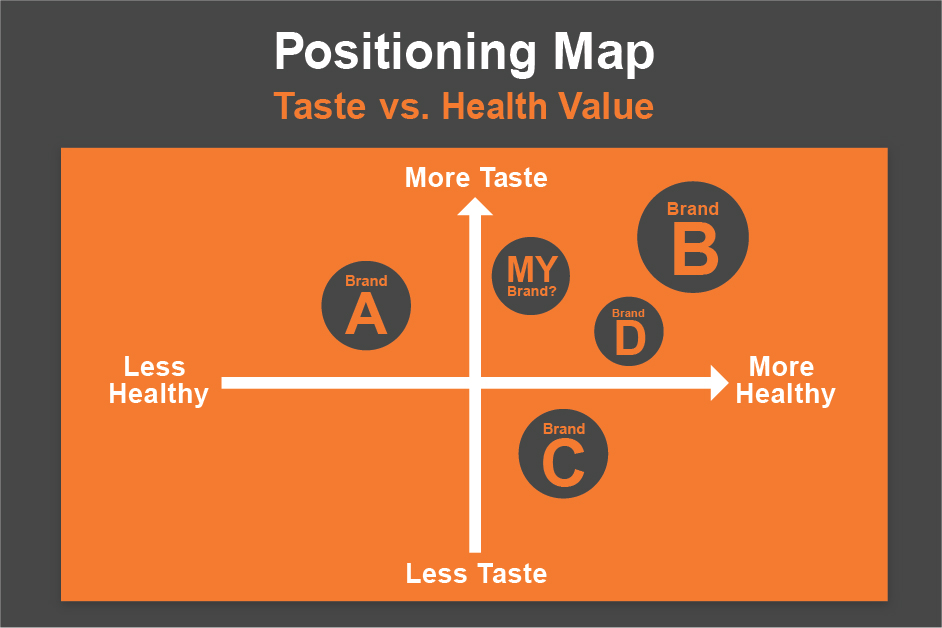Today, more than ever, businesses need the right strategies to compete and win in the hyper-competitive marketplace. No market or industry is exempt from the need to focus on and adjust the way they’re doing business.
To compete in such a brutally competitive environment, marketers must strategically plan their positions to give their products or services the greatest advantage to win.
The goal is to find the position you can own in the mind of your customers and prospects. Your position must have enough potential customers to make it profitable.
Most categories are filled with brands owning the most desirable attributes. So how do you find your brand’s place in the sun?
We recommend a "positioning map” (also known as “perceptual mapping”). It is a powerful tool to find your position, providing a visual representation identifying brand perceptions in your marketplace. To begin on your map, you’ll need a pencil and paper.
Positioning Map
- Draw a horizontal line, the X-axis, across your paper. Then draw a vertical line, the Y-axis, halfway across the horizontal line. You now have a box divided into quadrants.
- Think of two attributes very important, desired or meaningful to your customers. Maybe one of the attributes is “Healthy.” Your horizontal axis can be labeled “Healthy.” The left side of the horizontal line stands for unhealthy or low health, and the right side stands for very healthy.
- Another attribute important to your customers might be taste. So, the bottom of your vertical line can represent low taste, and the top of your vertical line can stand for high taste.
- Next, place a circle to represent each of your competitors on the graph where you think they are best represented in the minds of their (and your) customers.
- To give even more meaning to the graph, match the relative size of the circle to the brand’s market share. That is, the bigger the circle, the greater the share of the market.
- Finally, put your own brand, company, product or service where you think it best fits on the graph, including the size of the circle to represent your market share relative to the competition.
The resulting perceptual map might be a revelation. It helps remove some of the fog in your competitive marketplace and presents a clearer picture. It's a useful tool to find your position.
Objectivity is important in the positioning mapping exercise. We tend to overestimate the benefits of our own brand and underestimate those of our rivals, so consider working with a third party to remove this subjectivity.
An impartial third party can help you find what your customers value most and in what priority with a greater degree of certainty. A quantitative survey tool would provide the answers. What perceptions do your customers and prospects have of your competitors and your brand? The same survey would also answer these questions.
Positioning gap
The resulting positioning map allows you to visualize your brand versus competitors based on a two-attribute matrix.
Remember you are searching for your positioning gap. Is there a space or gap with little or no competition in the quadrant that represents tasty and healthy? If so, you might have found your brand position.
Is there a gap in the tasty but not-so-healthy quadrant with few or no competitors? Is that the position you’d like to own in the minds of your customers?
What about the not-so-tasty but very healthy quadrant? Is it available? Does it have enough of a market to be profitable?
The last quadrant, not-so-healthy and not-so-tasty, might be unoccupied. After all, if you’re going to eat something that isn’t healthy, it better at least taste good!
If you weren’t able to find a desirable positioning gap or niche, consider replacing one or both of the attributes with a different attribute your customers and prospects also care about.
Depending on your product or service, there are many attributes to consider: ease of use, financing options, availability of service, speed, frequent upgrades, color, fuel economy, beauty and style, reliability, strength, sexiness, environmentally friendly and other unique features and benefits. Your customers or prospects will tell you what they value.
The more meaningful the attribute is to your customers, the more potential market share. At the same time, you can expect greater competition with the more meaningful attributes. The object is to finding a profitable niche that you can own in your customers’ minds.
If, after trying several attributes, you were not able to find an available and profitable market gap, you still have options.
One is to adjust the existing perception of your brand to an area of the map that is less congested. This is called repositioning. There is a limit, known as brand stretch, to how far you can reposition an existing brand. It might be more effective to develop a new brand.
Another option is to segment your target audience — narrowing your focus. Find a target segment that is tightly aligned with a singular attribute, or brand position. A smaller business might be better able to serve a segment than its larger competitor.
Prepare another positioning map with these new parameters to discover if you’ve found an attractive position.
The increasingly competitive marketplace demands that marketers focus on being something for someone rather than nothing for everyone.
Being the bigger fish in a smaller pond might be better than being the small fish in a big pond. Customers are willing to pay a premium for a product that meets their needs more specifically, and that can result in larger margins and subcategory leadership.
If you need assistance on how to make a positioning map, contact Innis Maggiore to learn more about our positioning discipline and the Appreciative Discovery process.



